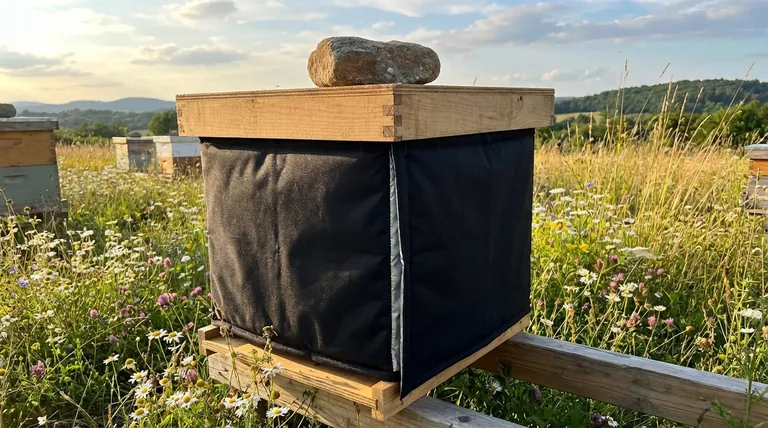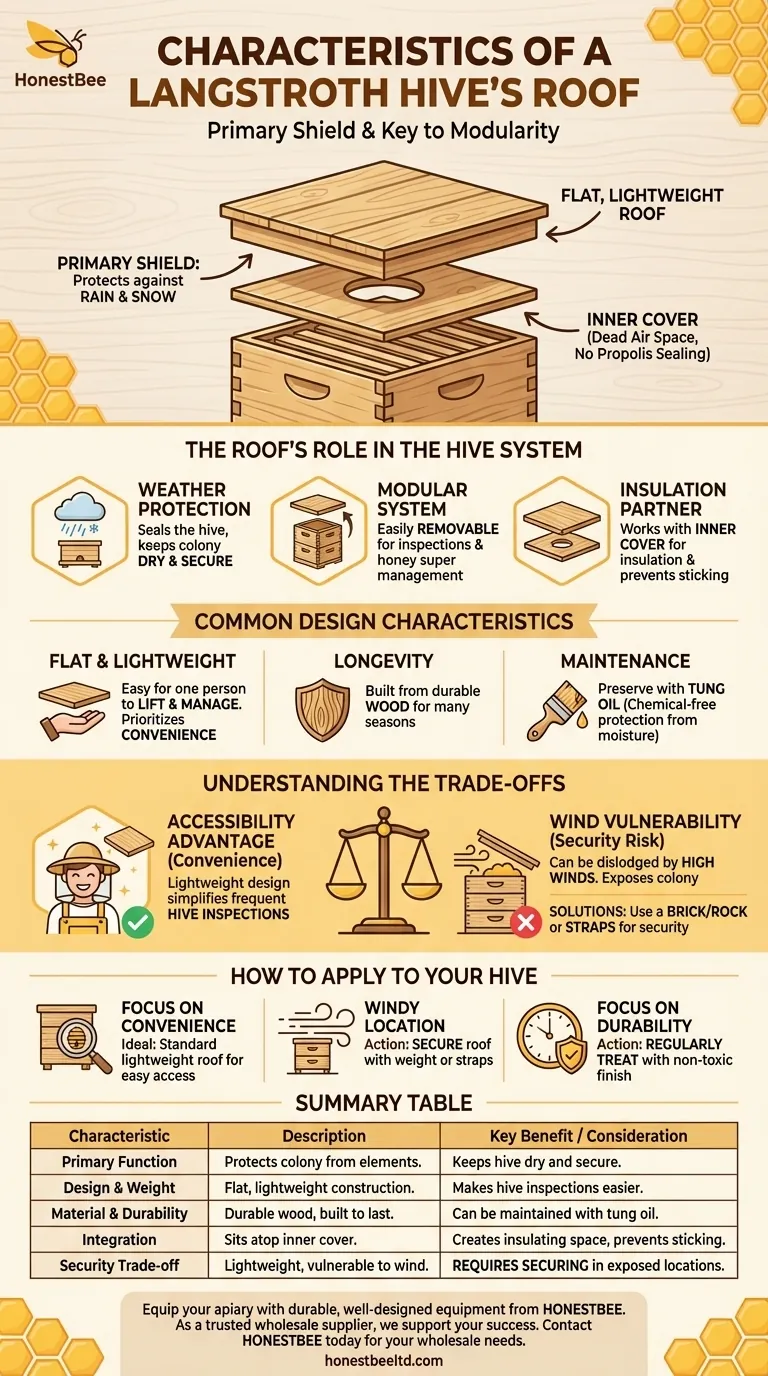At its core, a Langstroth hive roof is the hive's primary shield against the outside world. It is a removable top cover, typically designed to be flat and lightweight, which protects the colony from elements like rain and snow while sealing the top of the hive.
The Langstroth roof's design prioritizes beekeeper convenience and modularity. Its lightweight nature makes hive inspections easier, but this comes with a direct trade-off in security against high winds.

The Roof's Role in the Hive System
A hive roof is more than a simple lid; it's an integral component of the Langstroth hive's modular design, which is famous for its efficiency and ease of management.
Primary Function: Weather Protection
The most critical job of the roof is to keep the colony dry and secure. It seals the top of the hive stack, preventing water from rain and snow from entering and harming the bees or their stores.
Working with the Inner Cover
The roof does not sit directly on the frames. It is placed over the inner cover, which provides a dead air space for insulation and prevents the bees from sealing the main roof to the top box with propolis.
A Key Part of a Modular System
The Langstroth hive is a stack of components: a bottom board, one or more hive bodies (boxes), and the covers. The roof is the final piece that can be easily removed to add or inspect the honey supers (boxes) below.
Common Design Characteristics
While variations exist, most Langstroth roofs share a set of functional characteristics that align with the hive's overall philosophy.
Flat and Lightweight Construction
The roof is intentionally made to be relatively lightweight. This design choice makes it easy for a beekeeper to lift it off, inspect the colony, and manage the hive boxes without assistance.
Designed for Longevity
Hive roofs are built to last for many seasons. They are typically made of wood and can be maintained to withstand years of exposure to the elements.
Maintenance and Preservation
To maximize its lifespan, the wooden roof can be treated. A common, chemical-free method is to apply tung oil, which protects the wood from moisture and gives it a rich, natural color.
Understanding the Trade-offs
The design of the Langstroth roof is a clear example of balancing competing priorities. What makes it convenient for the beekeeper also creates a vulnerability that must be managed.
The Advantage of Accessibility
Its lightweight nature is its biggest benefit during hive inspections. A heavy, cumbersome roof would make the frequent task of checking on the colony much more difficult, especially for beekeepers who cannot lift heavy equipment.
The Disadvantage: Wind Vulnerability
The primary drawback is that a lightweight, flat roof can be dislodged or blown off completely by high winds. An unsecured roof can expose the colony to the elements, which can be devastating.
Common Solutions
Beekeepers have developed simple and effective solutions to this problem. Placing a heavy object like a brick or large rock on top of the roof is the most common method. For even greater security, straps can be used to cinch the entire hive together, from the roof to the bottom board.
How to Apply This to Your Hive
When managing your Langstroth hive, the roof's characteristics directly impact your workflow and the colony's security.
- If your primary focus is convenience and frequent inspections: The standard lightweight roof is ideal, as it minimizes the physical effort required to access the colony.
- If your apiary is in a windy or exposed location: Always plan to secure your roof with a heavy object or straps to prevent it from blowing off and exposing the hive.
- If your primary focus is long-term durability: Regularly treat your wooden roof with a non-toxic finish like tung oil to protect it from moisture and extend its working life.
Ultimately, viewing the roof as a functional component within a larger, manageable system is the key to successful beekeeping.
Summary Table:
| Characteristic | Description | Key Benefit / Consideration |
|---|---|---|
| Primary Function | Protects the colony from rain, snow, and other elements. | Keeps the hive dry and secure. |
| Design & Weight | Typically flat and lightweight for easy handling. | Makes hive inspections easier for the beekeeper. |
| Material & Durability | Usually made of wood, designed to last for many seasons. | Can be maintained with finishes like tung oil for longevity. |
| Integration | Sits atop the inner cover, not directly on the frames. | Creates an insulating dead air space and prevents propolis sealing. |
| Security Trade-off | Lightweight design can be vulnerable to high winds. | Requires securing with a weight (e.g., brick) or straps in exposed locations. |
Equip your apiary with durable, well-designed equipment from HONESTBEE.
As a trusted wholesale supplier for commercial apiaries and beekeeping equipment distributors, we understand that every component, from the roof down, is critical to the health of your colonies and the efficiency of your operation. Our range of high-quality Langstroth hive parts is built to meet the demands of professional beekeeping.
Let us help you build a more resilient and manageable beekeeping business.
Contact HONESTBEE today to discuss your wholesale needs and discover how our supplies can support your success.
Visual Guide

Related Products
- Professional Insulated Winter Hive Wrap for Beekeeping
- Professional Galvanized Hive Strap with Secure Locking Buckle for Beekeeping
- Professional Stainless Steel J-Hook Hive Tool
- Black Plastic Beetle Barn Hive Beetle Trap for Beehives
- Langstroth Screen Bottom Board for Beekeeping Wholesale
People Also Ask
- How does insulation help bee hives in severely cold weather? Conserve Energy & Ensure Colony Survival
- Why is it important to insulate beehives during winter? Boost Your Colony's Survival Rate
- What are the durability features of Bee Blankets? Built to Last in Demanding Apiary Conditions
- What is the advantage of an insulated outer cover? Boost Winter Survival & Spring Buildup
- What are the steps to properly wrap a beehive for winter? Ensure Your Colony Survives the Cold



















